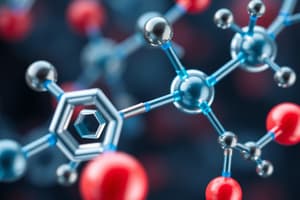Podcast
Questions and Answers
Which statement about glycogen is true?
Which statement about glycogen is true?
- Glycogen serves as a source of stored energy in humans and animals. (correct)
- Glycogen is structurally identical to lipids.
- Glycogen is a protein made of amino acids.
- Glycogen can be directly converted into nucleic acids.
What is the primary function of nucleic acids?
What is the primary function of nucleic acids?
- To store an organism's genetic code. (correct)
- To provide structural support to cell membranes.
- To regulate metabolic processes.
- To act as a source of long-term energy.
Which of the following best describes the composition of lipids?
Which of the following best describes the composition of lipids?
- Lipids are comprised of sugars and starches.
- Lipids are primarily composed of amino acids and nucleotides.
- Lipids are made of glycerol and fatty acids. (correct)
- Lipids contain exclusively carbon and oxygen.
Which elements are found in proteins?
Which elements are found in proteins?
What type of carbohydrate is formed by combining maltose and glucose?
What type of carbohydrate is formed by combining maltose and glucose?
What role do the alveoli play in the respiratory system?
What role do the alveoli play in the respiratory system?
What is one consequence of smoking on the respiratory system?
What is one consequence of smoking on the respiratory system?
Which of the following statements about emphysema is true?
Which of the following statements about emphysema is true?
Which harmful substance is NOT commonly found in cigarette smoke?
Which harmful substance is NOT commonly found in cigarette smoke?
What impact does smoking have on pregnant women and their babies?
What impact does smoking have on pregnant women and their babies?
What is the primary function of the pleural cavity in the respiratory system?
What is the primary function of the pleural cavity in the respiratory system?
How do cilia in the respiratory tract help maintain lung health?
How do cilia in the respiratory tract help maintain lung health?
What occurs when the diaphragm and intercostal muscles contract during inhalation?
What occurs when the diaphragm and intercostal muscles contract during inhalation?
What structural characteristic of alveoli facilitates efficient gas exchange?
What structural characteristic of alveoli facilitates efficient gas exchange?
What is the impact of smoking on the respiratory system, specifically regarding cilia?
What is the impact of smoking on the respiratory system, specifically regarding cilia?
Flashcards are hidden until you start studying
Study Notes
Biological Molecules
- Carbohydrates are made up of smaller units like glucose and maltose, which can be combined to form larger carbohydrates like starch and glycogen.
- Glycogen is the storage form of carbohydrates in humans and animals, while starch is the storage form in plants.
- Proteins are made up of amino acids, which are linked together in a specific order to form unique proteins.
- Proteins contain carbon, hydrogen, oxygen, and nitrogen.
- Fructose is a naturally occurring sugar.
- Nucleic acids, including DNA and RNA, store genetic information.
- Nucleic acids are composed of nucleotide chains.
- Lipids, like fats and oils, are composed of glycerol and fatty acids.
- Lipids are a source of energy, act as chemical messengers, and form cell membranes and organelles.
- Lipids are composed of carbon, hydrogen, and oxygen.
Gas Exchange and Breathing
- The pleural cavity is filled with pleural fluid, which acts as a lubricant.
- Cells lining the trachea and large airways secrete mucus to trap dust and bacteria.
- Cilia, tiny hairs, sweep dust and other particles out of the airways.
- Smoking damages cilia, increasing the risk of lung infections.
- Ventilation, the movement of air in and out of the lungs, is driven by pressure differences.
- When you breathe in, intercostal muscles contract and the diaphragm lowers, expanding the thorax and lowering the air pressure.
- When you breathe out, intercostal muscles relax, the diaphragm rises, and the thorax volume decreases, increasing air pressure.
- The lungs are elastic and tend to collapse.
- The lungs are responsible for absorbing oxygen and releasing carbon dioxide.
- The lungs contain millions of alveoli, which increase the surface area for gas exchange.
- Deoxygenated blood travels from the heart to the alveoli to be oxygenated.
- Gas exchange occurs across a thin membrane between the alveoli and capillaries, less than 1000 mm thick.
- Oxygen diffuses from the alveoli into the blood, and carbon dioxide diffuses from the blood into the alveoli.
- Oxygenated blood flows back to the heart.
- Smoking damages the alveoli, increasing the risk of lung infections, and hindering gas exchange.
- Smoking can lead to lung cancer, bronchitis, emphysema, coronary heart disease, and stomach and intestinal ulcers.
- Pregnant women who smoke are more likely to have underweight babies.
- Smoking destroys cilia, leading to mucus buildup and the smoker's cough.
- Emphysema damages the alveoli, reducing their surface area and making it harder to breathe.
- Lung cancer is often linked to smoking.
- Cigarette smoke contains harmful substances like carbon monoxide, arsenic, ammonia, cyanide, benzene, and other carcinogens.
Studying That Suits You
Use AI to generate personalized quizzes and flashcards to suit your learning preferences.




